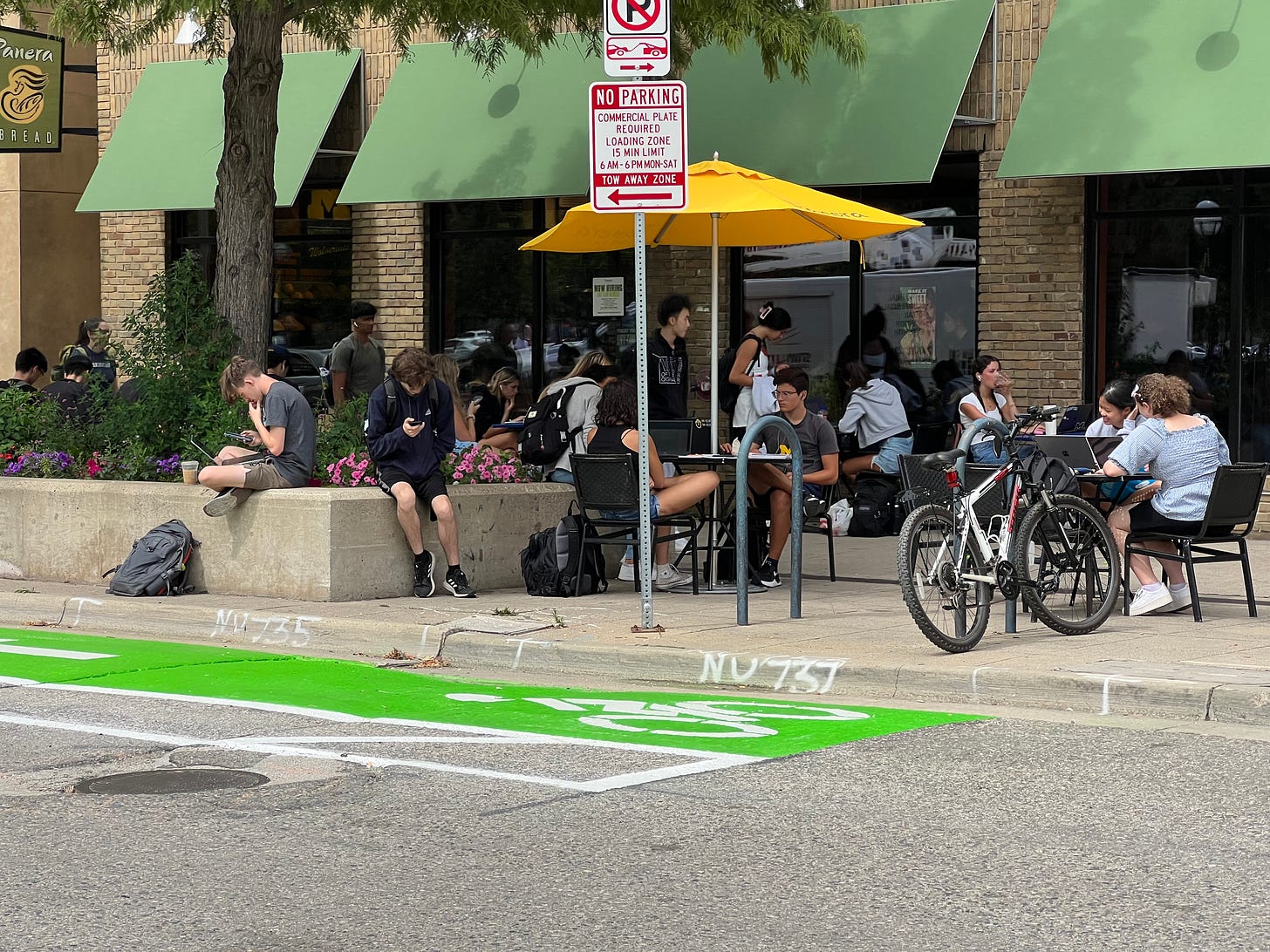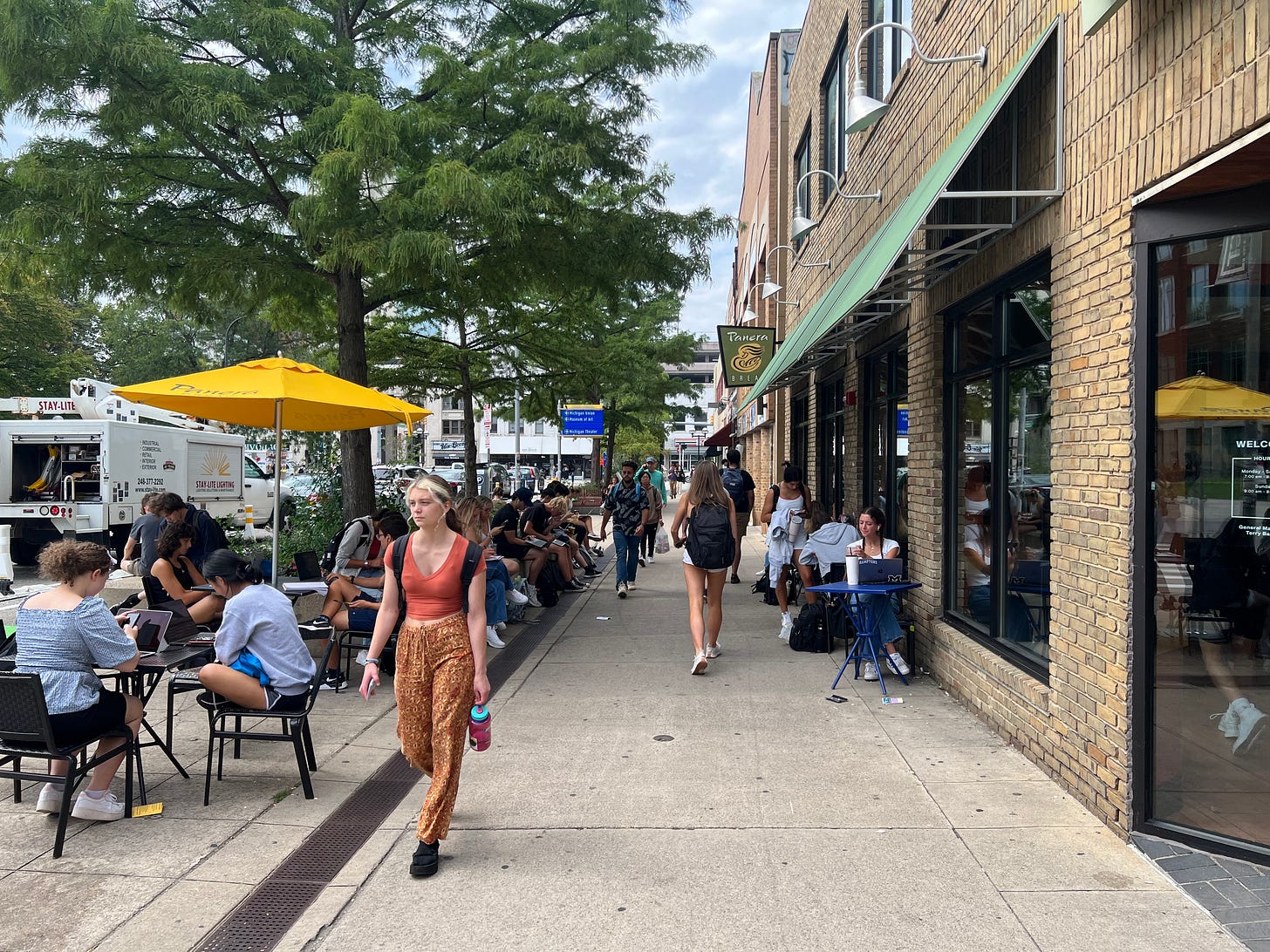How do you make the start of the school year even more exciting than usual? Disconnect some 50,000 students from the internet during the first week of classes with only terse explanations that there’s a security incident underway. This left people on campus to speculate whether the outage was the result of a ransomware attack, state-backed hacking attempt, or perhaps just an overzealous squirrel. But while high drama unfolded on campus, it created a pause to revisit the fundamental question—our first question—what is urban technology?
💬 Hello! This is the newsletter of the Urban Technology program at University of Michigan, in which we explore the ways that data, connectivity, computation, and automation can be harnessed to nurture and improve human life in cities. If you’re new here, try this short video of current students describing urban technology in their own words.
🌁 What is Urban Technology?
When U-M consciously uncoupled itself from the open internet and took down local WIFI, tens of thousands of students freshly arrived to Ann Arbor got a free ride in the time machine back to the early 1990s: Internet-less and free.
People living off campus with their own broadband connections were unaffected, so some people stayed home. But lots of people, unable to email their professors or get email from the same, were out and about, showing up to classrooms to sit around with other people a little perplexed at how to navigate the connected world without any connection.
Cellphone hotspots flared up, with students sharing bandwidth from a cellphone laid delicately on a cafe table or picnic bench, everyone keeping a respectful distance as if to not interfere with the signal while trying to stay close enough to wring out a few extra Mbps. This worked for a while but quickly the cell networks were saturated. Lucky ones got online, but some (🙋) could barely load simple all-text emails on their phone.
The penumbra of Panera to the rescue! Planter ledges and cafe tables that often have 1-2 people sitting on them were suddenly full of people finding a place to linger within the catchment of corporate largess.
So here’s the question I would ask these students: is this also urban technology?
If we use Stonly Baptiste’s article from 2019 focusing on urban verticals as the definition of urban technology (mobility, property/real estate, food, etc.), a connectivity outage would not really fit. We could use verticals/industries to talk about what’s happening above in the images but it quickly gets tangled: a failure of “infrastructure” spills technology into new parts of the “built environment,” introducing new examples of the sharing economy with shades of of “civic solutions.” This shows us that verticals makes more sense from the perspective of an investor, which was the POV of Baptiste’s article, but still leaves out much of the phenomena of a scene like the one above.
Let’s try defining urban technology with a how and a what. Urban technology is about the ways that data, connectivity, computation, and automation change the how we see, shape, and spend time in cities. Data, connectivity, computation, and automation are the ‘how.’ See, shape, and spending time in cities are the ‘what.’
SEE → This is about proliferating data where it was previously scarce. Cheap sensors and wireless modems, good quality batteries, and improvements in material science have let loose instrumentation of the physical world. Stormwater is quantized. Bridges watch themselves for stress fractures. Air quality widely monitored. HVAC systems and appliances keeping their own pulse. Satellite imagery of the earth’s surface is effectively realtime. Standardized and open data formats. All of this data capture leads to new visualizations and analysis that help people understand the city from novel perspectives and, eventually, make decisions from those vantages. The net result of seeing the city through data is that it creates the possibility of new feedback loops—new levels of responsiveness from your home, your city, and your transit network, your mayor, etc. If you know how a thing is performing, you can demand it to perform differently.
SHAPE → This is (mostly) about automation: in the design environment, in public engagement settings, and on the construction site. Generative design, parametric/automated design systems, computational zoning analysis, 3D-printed housing and infrastructure, responsive or mediated environments, vertical integration of the construction supply chain, realtime visualizations in game engines, XR and other multimedia engagement tools during the planning process. These technologies are examples of how the design and delivery of buildings, public spaces, and infrastructure are being modernized, albeit still slowly. But the big story here is economic. So much of the way that the built environment is delivered is labor-intensive and organized as service-businesses. When urban technology changes how cities are shaped, it almost always involves automation in the form of new products. When shaping technologies work, the balance tips from service to product. Product businesses are more investable, so this has the potential to set off a flywheel of increasingly rapid changes in the tooling, processes, skills needed to shape future cities.
SPEND TIME → This is about urban services that use a digital layer to enable new uses of physical assets. Ring doorbells. Scooters and bike share. Curbside EV charging. Microgrids. Google Maps, Yelp, and Nextdoor. The outcomes from urban tech services are often some kind of distortion of the status quo. Bike and other sharing platforms facilitate slicing the rentals into ever-thinner slivers, changing our relationship to time. Ride hail has mobilized millions of strangers to connect through the bond of shared incentives, playing with our sense of trust. Airbnb and other space rental platforms have opened up new geographic possibilities and new vectors of community conflict, changing our relationship to space and place.
Framed as a question of how humans see, shape, and spend time in cities, an internet outage during week one of classes is no longer (just) a study in failure, but a generative moment for scholars and, I suspect, also for investors and entrepreneurs, and policy makers. It helps us ask questions.
With people flocking to places they would not usually be in such quantity, their bodies help us see the invisible trace of 5GHz wifi signals that lace the street. What other ripples in data happened on those days and what can we learn from them? As for how an experience like an internet outage might shape cities, there’s no better way to rethink the space around you than by studying the coping mechanisms of real people going about their day, just like all of the college students in the photo above. The conditions at that time were motivated by a massive hiccup, but what do they tell us about how else we might live in the city of Ann Arbor? Even as simple as: how could more people be convinced to spend more time outdoors? Finally, an outage is a kind of urban service, if you stretch your mind to think of it that way, and it profoundly enabled people to spend time differently. I hope at least a few people discovered that technologies to make city life more urbane don’t always have to be about what’s added. Urban technology should be defined capaciously enough to include suggestions of when it’s better to get technology out of the way—which is a thing, but let’s not make it a thing on the first day classes.
If we’re making the most of the unusual start to the semester, this brings me to an interview with Herbie Hancock that I once read about navigating to better outcomes.
Hitting a noticeably wrong chord, Hancock reacted as most of us would, with dismay. “Miles [Davis] paused for a second,” he says, “and then he played some notes that made my chord right… Miles was able to turn something that was wrong into something that was right.” Still, Hancock was so upset, he couldn’t play for about a minute, paralyzed by his own ideas about “right” and “wrong” notes.
Herbie Hancock continued, “What I realize now is that Miles didn’t hear it as a mistake. He heard it as something that happened. As an event. And so that was part of the reality of what was happening at that moment. And he dealt with it…. Since he didn’t hear it as a mistake, he thought it was his responsibility to find something that fit.”
We should care about using an expansive definition of urban technology because technology breaks, critical infrastructure is attacked, and surprises happen. If we educate a generation of students who think about urban tech only as building new things, they’ll be stuck when life gets complicated. Instead, we want to prepare students who are capable of hearing past the mistakes.
These weeks: <stretches arms, hands, and fingers> Among the many things we did during the summer break, we were joined by a new program assistant. Welcome, Mariah! 🏃





